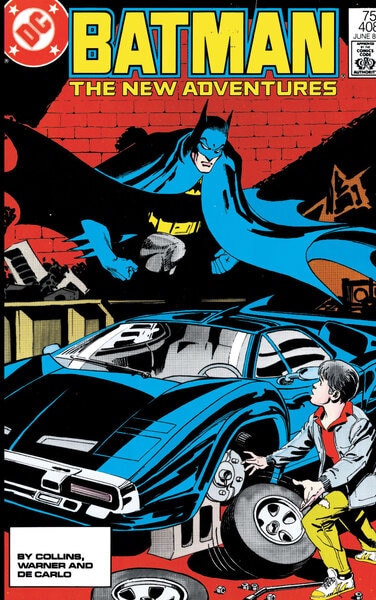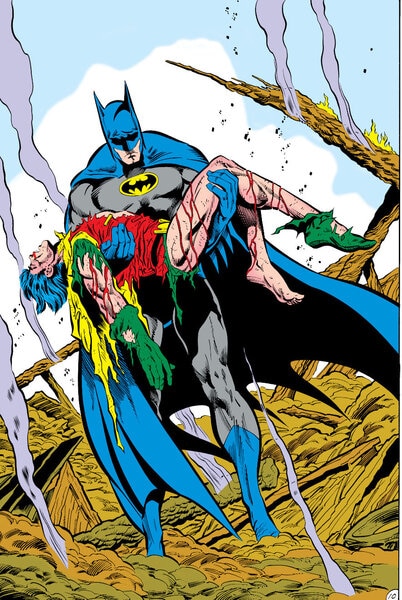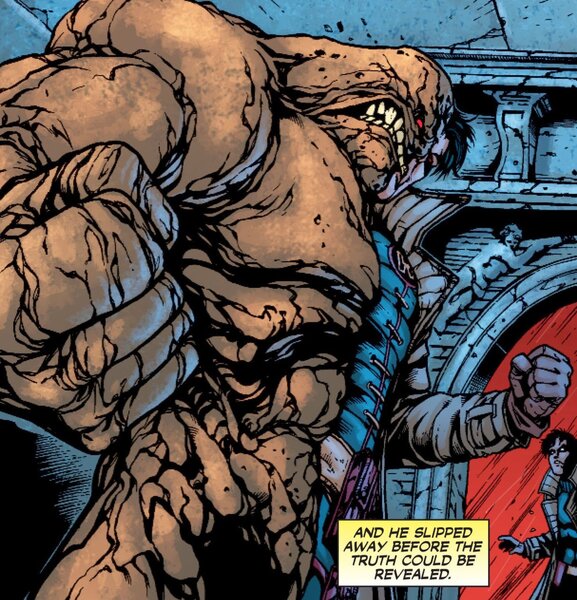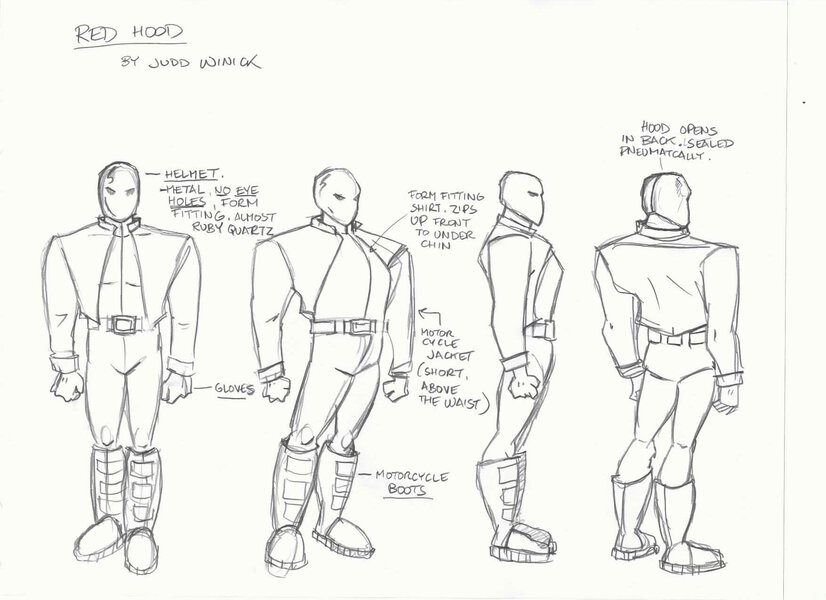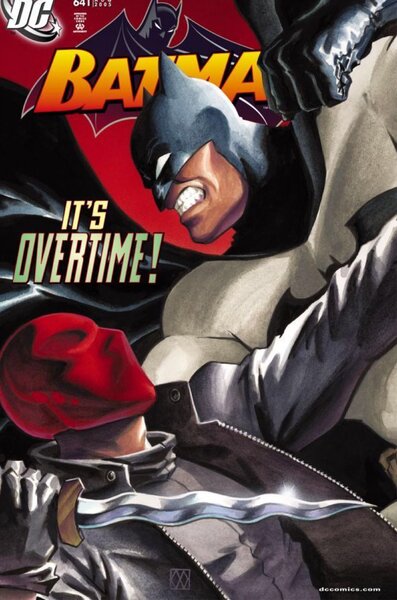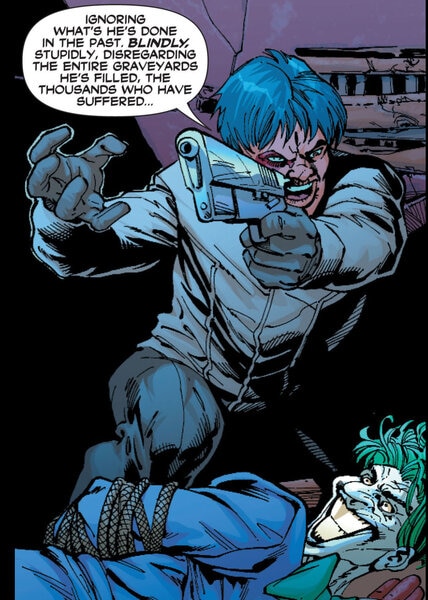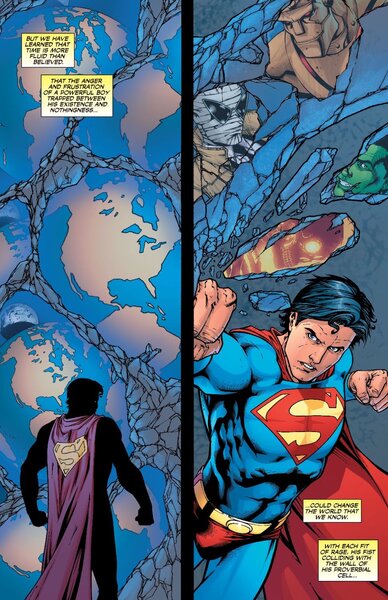Create a free profile to get unlimited access to exclusive videos, sweepstakes, and more!
Behind the Red Hood: An oral history of the death and resurrection of Batman's second son
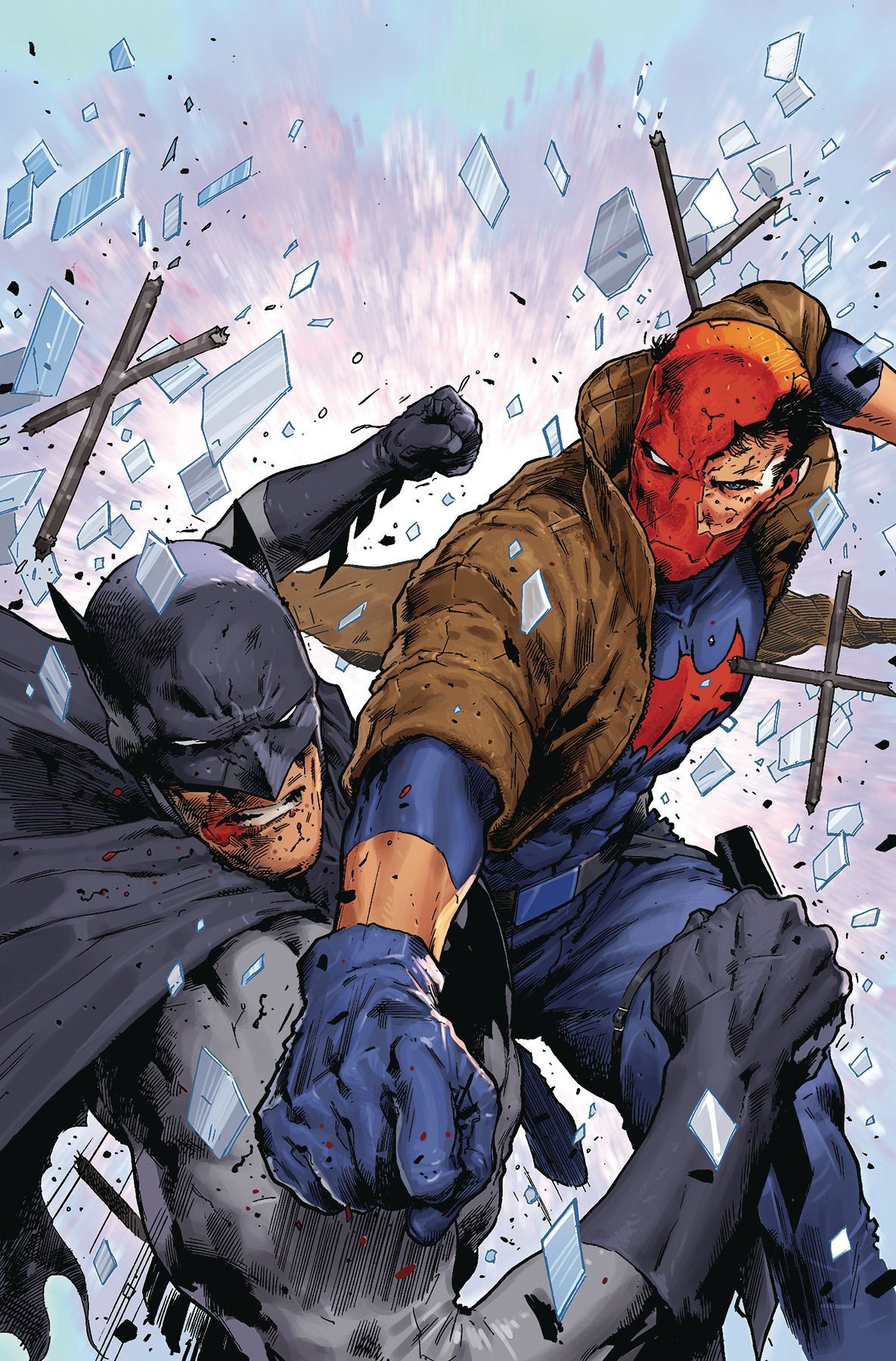
The creative history of Jason Todd, the second character to hold the mantle of Robin the Boy Wonder, is best told in three parts. Beginnings (yes, there are more than one), middle (which is really an ending), and rebirth. To tell that complicated story, SYFY WIRE has enlisted the help of Paul Levitz, editor Bob Schreck, writer Judd Winick, and artist Doug Mahnke to help chart the evolution of Jason from Robin to Red Hood.
Jason Todd was at first the second Robin, taking over after Bruce Wayne's original partner, Dick Grayson, dropped the mantle and eventually became Nightwing. When he first appeared as Robin in Batman #368 in 1984, Jason was introduced as more or less a carbon copy of Grayson; he had a circus acrobat background, was orphaned by criminals, taken in by Bruce Wayne, etc. A year later, though, everything changed when DC published Crisis on Infinite Earths.
The event served as a creative reset of the DC Universe, allowing for contemporary retellings of the origin stories of many of DC's flagship characters. This was the bedrock on which writer Frank Miller and artist David Mazzucchelli's classic storyline Batman: Year One was built. With this new take on Batman also came a new take on the second Robin. This post-Crisis version (first appearing in Batman #408) of Robin was as far removed, personality-wise, from any version of Dick Grayson or Jason Todd readers had previously known.
This Jason Todd was still an orphaned street kid, but one Bruce caught in the midst of committing an incredibly dumb petty crime: boosting the tires off the Batmobile.
Street-smart and a quick study, Jason quickly stepped into Robin's tights. But he wasn't the squeaky-clean hero of yesteryear; the writers of this new Jason also leaned into his mean streak, with Jason embodying both an anger and an emptiness that expressed themselves as a razor-sharp edge that was troubling to both Batman and fans of Robin alike. So during a storyline that ran through the Batman title A Death in the Family by writer Jim Starlin and artist Jim Aparo, DC took the unprecedented step of allowing fans (who had voiced their displeasure at this darker turn to the Robin character with many letters to the DC offices) to call in to a hotline that would allow them to decide the fate of the new Robin. The phone line wasn't the first for DC.
"Back in the late '70s we had a call-in number called the DC Hotline, short recorded plugs for comics coming out that week," Levitz explains. "It was Mike Gold's brainchild and allegedly generated so much traffic when school got out that it crashed phone company circuits."
The vote swung against Jason by the slimmest of margins and he was killed off in Batman #428, blown to smithereens after a savage beatdown delivered by a crowbar-wielding Joker — Batman arrived seconds too late to save his partner.
It was a rough way to go, and with his death determined by a paper-thin margin of just 64 votes, no one was particularly happy with the result. It was the first and the last time the call-in gimmick was employed, for obvious reasons.
"Jason Todd's death and negative press reaction may have left a bad taste in our mouths," Levitz says.
And that was that. Jason Todd's fate endured for decades until Bob Schreck arrived at DC, fresh off an already extensive career in comic book publishing, including at creator-owned imprint Oni Press, which he co-founded.
Winick: When Bob got the big-shot job at DC comics, about a year into his stint there he gave me a call. The conversation went along the lines of "Do you like superhero comics?" "Yeah, I do. I love them," I said. He says, "You know, you're the only person I've ever worked with thus far who hadn't called me to look for work from DC. There are people I don't like who have reached out to me! So what's up? Do want to write a superhero comic?" Of course, I do. Everybody's got a Rabbi. Mine was absolutely Bob Schreck; he believed in me, took care of me, and made sure that I was doing good work.
Judd would start his career at DC on titles like Green Lantern before adding stints on Green Arrow and, eventually, Batman to his regular scripting duties at DC.
Schreck: Judd had already taken over Batman with artist Dustin Nguyen on a Scarecrow story. While pitching future stories for the book, he thought it would be a great idea to bring Jason back. Because he read the Batman: Hush storyline, which originally kind of nodded toward Jason Todd being the Hush character for an issue. I think that had a big hand in Judd thinking that way.
Bringing Jason back was divisive, just as killing him was.
Winick: It's simply because I thought they were going to do it. It was such a terrific idea! As a reader, when Jeph Loeb and Jim Lee did their run on Batman: Hush and they toyed with the idea of revealing Hush as Jason at the end of one issue, in my mind's eye I broke it all down. Everything down to how he'd come out of Lazarus Pit. I thought that was incredible. Like a hundred miles of broken road, I just saw the opera of it. I was genuinely excited to read it. Then the next issue came along and they took it back: "No, it's not Jason. It's just Clayface!" After that I couldn't let go because it just made sense to me.
Schreck: I was not happy about the idea. This whole thing of bringing back people, I mean, it's been done so many times. Gosh, do we really need to do this again? It's an old trick. These guys never die.
Winick: I don't think it took away anything from the Batman mythos. The idea of what Bruce lost. In my opinion, he still lost Jason and everything that went with it. The guilt and what it turned him into in that era, that kind of what really made him into the Dark Knight that we knew coming after Death in the Family.
Schreck: I kind of pushed back against it, and Judd was pushing back against me. I eventually said, "Okay, look, if this is something you really, really want to do — and you can get Dan DiDio's blessing — I'll come along for the ride and I will do my due diligence, but I'm not happy."
Winick: Bob didn't like it when I originally pitched it to him. Which is an amazing thing. Bob is an amazing editor on many levels. He didn't really like the story, but he knew it was good. I don't know who does that? Is anyone that mature? But Bob was. He comes in with a follow-up pep talk like, "No, I just want you to know that I don't think this is my cup of tea but I think it's going to be great, and we're gonna make it great."
Schreck: Eventually, it all did come together. Judd's a great writer, and he really did make it a fun run. As time went on, I thought it came together nicely.
Winick: Bob's challenge to me was "I want you to prove it to me. Just keep doing it." We're like five, six issues in and he goes, "Okay, I get it." I go, "How did you not get it before?" To which he replies, "I know you think you're showing me in your outlines. But I didn't see the story yet. I didn't see the pathos. I didn't see the opera. Now I do." I say, "Great, all right, that was terrifying."
Schreck: The story was brewing in Judd's skull for quite some time. He was plotting away before we even got the green light from Dan DiDio. I think I brought up Doug Mahnke because I had worked with him on the marketing of The Mask for Dark Horse.
Winick: From the jump, we knew that Doug was going to be the artist on this. I was really excited about it. I can't even say enough. The thing I always loved best about Doug is that he does great acting. These aren't just cookie-cutter characters. No one looks the same. Everyone has a quality to them, height, weight, and there's emotion there.
Doug Mahnke: I remember actually a few details that had come to me, but I'm mostly hazy on how I got onto Red Hood. I know they originally came to me and asked me if I wanted to do Nightwing. I declined, I wanted something with a higher profile. Considering where I had been, coming off a stint on Justice League. And then they came back at me with Batman.
Keeping in mind, Mahnke wasn't terribly familiar with the scope of what he was getting into.
Mahnke: What you're going to discover is just how incredibly ignorant comic book artists can be. When I started working for DC, I really didn't know very much about DC other than just the primary characters. I was basically a Marvel kid, then I dumped comics for a while. When I came back and started collecting stuff, it was Love and Rockets, ABC Warriors, Heavy Metal magazine, etc. So every time I worked on a book, it was just kind of focused on that moment as opposed to acquiring any knowledge that existed well beyond the little confines of where I was. I mean, I didn't even know about Jason Todd. I got up to speed, of course, but as I entered into it, they could've told me anything. It was like, "Yeah, that's cool. You know, I'm ready to draw!" I didn't appreciate the gravity of the situation. The fact that they're bringing back a character that the fans had elected to kill, and all the cool stuff that circled around the history of the character, and now he's coming back after quite a while of being gone.
The name, the Red Hood, was meant to evoke one of the Joker's earlier identities, but the look for Jason's version had to be a little different.
Winick: I originally designed Jason's look for the Red Hood. I had him sort of like the original Joker version that he had no eye slots. That solid kind of quartz, metal helmet thing. And Doug came back with eye holes, reasoning being, "Well it's gonna really be hard in close up, and three-quarter turns, to tell what's going on. You're just gonna lose him." "I'm like, what are you talking about?" And then I realize, "Oh, he's right! I see what you're saying. Yeah. It's the face." I think he thought it was just going to be a little bit weird, and you know what? He was right. I've seen other versions floating around here and there, and when he's got nothing there with his eyes it just doesn't look quite right. No eyes offers a futuristic quality to the Red Hood that you just don't want.
Winick: It's also funny that cover artist Matt Wagner had already done a number of covers based on my original design. He was well down the pipe prior to Doug starting on the book, and by the time he did: eye holes. At which point Matt was like, "You know, we're not matching up here. But I don't care. Let's just say we're going for symbolism."
Mahnke: What I remember is that I was cool to have Matt Wagner do covers, with his pedigree. I think it obviously fit well with Bob Schreck's preferences instead of being just straight-up line art and normal comic book stuff. Plus a Wagner cover carries a certain amount of weight to it.
While it was a masterful stroke naming Jason's new masked persona after a role originally made famous by the Joker, Winick isn't exactly sure of how that all came together.
Winick: It at some point just clicked in my head. The original Red Hood/Joker is such a great story in the first place. I always loved the idea that Batman inadvertently created him. It's such a deeply rich story. Alan Moore did it so well in The Killing Joke. So that always stuck with me. I think I just put two and two together. For Jason, it was a real middle finger to Joker. Bottom line, it would mess with Joker, it would mess with Batman. I think that's what Jason wanted.
Schreck: This was something that was in Jason's craw. He was quietly sitting back and waiting for his time for revenge on everyone. I think making him this kind of this angry person that wants some sort of retribution out of his treatment over the years hit the nail on the head.
The storyline ran through Batman for over a year, culminating in Batman, Jason, and the Joker squaring off for a final confrontation. Jason had spent a majority of his time in Gotham after his return quietly torturing the Batman and uniting several gangs under his influence. He fashioned himself as Gotham's newest crime lord, challenging Black Mask with the ultimate goal of ridding Gotham of its less savory characters. While his goals were similar to Batman's, the means were far more violent.
Winick: I had the ending all right from the jump. I just had to run it by Dan DiDio. It was at San Diego Comic-Con. I think I was the first of his four breakfast meetings that day he was going to have. So I just outlined the story, and that it ends with Jason taking the Joker, kidnapping him, threatening to kill him. During the fight, Bruce says, "I'm sorry I didn't save you." And Jason tells him: "That's not what this is about. This isn't because you didn't save me, but that you didn't kill the Joker. You let him live." Dan's like, "That's how you're ending the thing?" I said, "Yes!" Dan said, "Okay, go ahead and write that!"
The initial storyline ended, but the Red Hood's popularity was evident. The only thing missing from the story would be an explanation of how Jason returned, which occurred two months later in Batman: Annual #25.
The initial element from Judd's original pitch of the Lazarus Pit and Ra's al Ghul being involved were there, but there was an added twist to the proceedings thanks to another line-wide reality rebooting event caused by Superboy-Prime called Infinite Crisis that ran through all of DC's titles at the same time.
Winick: Real early on we had talked about the Superboy reality-altering punch. Geoff Johns, Greg Rucka, and Dan DiDio had made a list of events which were going to get undone because of the punch. Jason was kind of one of the bigger things that Superboy would eventually undo. So that was in there and that was looming.
I thought about it, and I thought the fans were going to kill us for trying to do this crazy story and end it with a Superboy punch. I didn't think we can do it. Dan agreed ... and then we changed our mind again and went with it. I think our changing our minds came when we were out and about, at conventions and people were just so hot for Infinite Crisis. It was all anyone's talking about, and we just decided to stick to our guns and just go with it.
Winick: In hindsight, it made sense at the time. Tonally, it was right. This is the story we're doing. This is what we were committed to originally. But it didn't weather well at all. It looks super dopey. There was no way around it. Which is why, when I had the opportunity to do it over again for the animated movie, I went with one of my original ideas: Ra's gets Jason's body and throws it into the Lazarus Pit.
In the post-Crisis world, it was revealed that a miraculously living Jason had clawed his way out of his coffin bare-handed and wandered the Gotham streets, practically catatonic, before collapsing. He then spent a year in a coma and, upon waking, returned to the streets with little to no memory of his life before death. That's where Talia and Ra's al Ghul come in, kidnapping him from Gotham and restoring his health and memory by throwing him into a Lazarus Pit. But the maddening effects of the Pit and the al Ghuls' influence led Jason to crave revenge; he embarked on a world-spanning tour to beef up his fighting skills, following in his former mentor's path, in order to be able to return to Gotham and enact his plan.
With all these details in mind, Judd was able to revisit the original story he reintroduced Jason with when he scripted the Warner Bros. Animation's adaptation Batman: Under the Red Hood, which was released in 2010.
Winick: I forget exactly where on the grapevine I had heard that Warner Bros. was looking to get a little dark in with their animated movies. This was around the time of Nolan's The Dark Knight. I thought, "Screw it, I'm going to pitch them Under the Red Hood." I found out later from Bruce Timm that he heard I was coming in. He told me he was fully in the camp of "We are not going to do this." As far as he was concerned, he liked the story but figured you'd have to tell all of Death in the Family for Jason's death to mean anything. We don't have time in a 70-minute feature to tell the whole thing.
So he's hearing my pitch. I say, "You do it chronologically. You begin with the teaser before the opening credits. That teaser should be the last few pages of the death of Jason Todd." Bruce tells me, "You cracked it! That's how you're supposed to do it." He said after he heard that part, the rest was a blur, he wasn't even listening. He was sure they were doing this.
As far as the adaptation process itself:
Winick: I had the luxury with the animated movie of making it smaller. So I took that smaller story and got to expand on some of the good parts. It was a lot of fun for that reason. Collaborating with everybody and watching this new version of it come to life. With the actors coming in and bringing it further to life. It's a blast. I'm still very proud that how much people still like it. Both the comic and the animated movie.
In hindsight, everyone involved with Jason, who is now one of the most popular members of the "Batman Family," is proud of what they helped to bring back, even as the character makes the turn from vengeance-fueled killer to antihero.
Schreck: There's an old adage: "Front-page news is always bad business, and good news usually only makes it to the back pages." I think making him this angry person that wants some sort of retribution out of his treatment over the years made him quite endearing to many folks.
Mahnke: I'm not surprised by Jason's appeal. When he came on with such a vengeance and the style of character that he was. Very heavy-handed in the idea of his version of justice. It was something that DC was ready for. The reasoning behind Jason's motivations were perfectly aligned with his aggression. Validated in that he had more than a couple of axes to grind on his return.
Winick: I am deeply surprised by Jason's staying power, and at the same time very, very proud. You don't know what's gonna hit. I loved this story. I loved it when I thought they were doing it in Hush, before it was even my story. All that said, I'm still honestly surprised. It belongs to the DC Universe. Myself and Doug are the guys who get the credit for reintroducing Jason to the world, but he belongs to everybody now.
